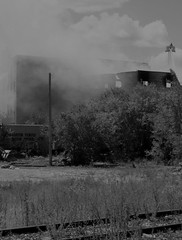Hell's Hundred Acres
 There once was a neighborhood that was, for a brief period of time, its city's most desirable place to live. This changed by the end of the 19th century, as the refined residents began to move out, and industries--with their poor workforce in tow--moved in. Into the 20th century, the area was considered an "industrial slum", and like the wealthy residents of an earlier time, the industries that with the ability to, moved out to more spacious quarters. The poor residents left, too, and the area faced massive depopulation and economic stagnation. Fires in the old warehouses occured so frequently that the area came to be known as "Hell's Hundred Acres". The old buildings were considered eyesores, and the traffic engineers began to circle around, hoping the area would be cleared for expressways.
There once was a neighborhood that was, for a brief period of time, its city's most desirable place to live. This changed by the end of the 19th century, as the refined residents began to move out, and industries--with their poor workforce in tow--moved in. Into the 20th century, the area was considered an "industrial slum", and like the wealthy residents of an earlier time, the industries that with the ability to, moved out to more spacious quarters. The poor residents left, too, and the area faced massive depopulation and economic stagnation. Fires in the old warehouses occured so frequently that the area came to be known as "Hell's Hundred Acres". The old buildings were considered eyesores, and the traffic engineers began to circle around, hoping the area would be cleared for expressways.In the background, things started to change, slowly and quietly. Artists--almost always the poor ones at the margins of their disciplines--begin to move into the old buildings in Hell's Hundred Acres, and use them to live and work. Often, doing so was against zoning regulations, and meant going without hot water or electricity. But the artists loved the buildings, and the beat character of the neighborhood anyway. In a neighborhood so forgotten and despised, they could be pioneers both in art and urban life. For years, no one noticed them and what they were doing.
Eventually, of course, they did, and today, Hell's Hundred Acres is known as SoHo, one of New York City's most famous, trendy and upscale of neighborhoods.
 The Winnipeg commuters who stare down from the Disraeli Freeway at another burned out warehouse today, may not notice the good things happening in Point Douglas, either. Nor would City Hall, or the whole Take Spirited Pride BIZ machine. They are probably not aware that two of Winnipeg's most well-known current artists live in South Point Douglas, among many others. They are probably not aware that scores of trust-funded artschool kids pour into the neighborhood for late-night parties. They are probably not aware that the best art shows are in Point Douglas' back lanes and loading docks. Even if they were, some would likely despise all this, given the hostile philistinian attitude the permeates the city. But whether they notice and appreciate it or not, more and more (young) people are noticing, and things are quietly improving, even while Higgins and Annabella looks like TV footage from Beiruit.
The Winnipeg commuters who stare down from the Disraeli Freeway at another burned out warehouse today, may not notice the good things happening in Point Douglas, either. Nor would City Hall, or the whole Take Spirited Pride BIZ machine. They are probably not aware that two of Winnipeg's most well-known current artists live in South Point Douglas, among many others. They are probably not aware that scores of trust-funded artschool kids pour into the neighborhood for late-night parties. They are probably not aware that the best art shows are in Point Douglas' back lanes and loading docks. Even if they were, some would likely despise all this, given the hostile philistinian attitude the permeates the city. But whether they notice and appreciate it or not, more and more (young) people are noticing, and things are quietly improving, even while Higgins and Annabella looks like TV footage from Beiruit. In hindsight, I believe that in 2006, creative graffiti artists will have done more to improve this city than politicians and booster groups did. For now, they carry on in the background, as almost all good things in Winnipeg do.

1 Comments:
1ajs -
well said :)
Post a Comment
Subscribe to Post Comments [Atom]
<< Home